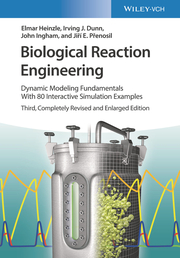-
Zusatztext
-
Die Dynamik biotechnologischer Produktionsprozesse ist äußerst komplex. Ziel des Buches ist es, diese Vorgänge durch systematische Modellbildung und Computersimulation verständlich und durchschaubar zu machen. Es werden ohne viel mathematisches Rüstzeug Grundprinzipien erklärt und anhand von zahlreichen praxisrelevanten Beispielen alle wichtigen Aspekte der Bioverfahrenstechnik ausführlich beschrieben. Modellierte biologische Systeme reichen vom einzelnen Enzym bis zu ganzen metabolischen Netzwerken und Multi-Organismen Systemen. Die kinetischen Modelle werden mit Reaktormodellen kombiniert, was oft mit verschiedenen Konfigurationen von Zu- und Abläufen und Stofftransportprozessen kombiniert ist. In vielen Beispielen werden Regelung und Optimierung der Prozesse behandelt. Die Simulationsbeispiele reichen von theoretischen Schulbeispielen bis zu aktuellen Forschungsarbeiten. Die verwendete Simulationssprache Berkeley Madonna erlaubt nach einer sehr kurzen Einarbeitung ein schnelles interaktives Üben. Der Leser kann die vorgegebenen Beispiele beliebig verändern, um sie seinem Problemfall anzupassen. Die langjährige Lehrerfahrung der Autoren an Hochschulen und Weiterbildungskursen spiegelt sich in dem Buch wider und macht es geeignet für alle Biochemiker, Biotechnologen, Bioingenieure und Verfahrenstechniker, die an Modellierung und Simulation interessiert sind. Die eingesetzte Software Berkeley Madonna für Mac und PC kann direkt von der Berkeley Madonna Webseite bezogen werden: www.berkeleymadonna.com Zusätzliches Online Material, d.h. Programme für alle Simulationsbeispiele, eine kurze Beschreibung der Verwendung der eingesetzten Simulationssoftware Berkeley Madonna und Lösungen von Übungsaufgaben kann als Zusatzmaterial (Zip-Datei) direkt von dieser Webseite heruntergeladen werden. Alle Beispiele können auch mit der kostenlosen Demo-Version von Berkeley Madonna benützt werden. Für Käufer des Buches ist Berkeley Madonna zu einem reduzierten Preis erhältlich. Hinweise dazu gibt es im Anhang des Buches.
-
-
Kurztext
-
Biological reactions may be mediated by enzymes, and whole microbial, animal or plant cells are at the core of many processes and products in a wide range of industries, such as the food and beverage, health, pharmaceutical, environmental, and chemical industries. Biological engineering has gained in breadth as we have moved from traditional biological processes for chemicals and pharmaceuticals to modern biotech medicine, and to specialty chemicals for food and industrial use. Biological engineering represents the heart of the biotech industry, such that the scaling of high productivity processes as well as the increased use of automation is critical. This book presents the modeling of dynamic biological engineering processes in a readily comprehensible manner, using the unique combination of simplified fundamental theory and direct hands-on computer simulation. The mathematics is kept to a minimum, and yet the 80 examples supplied on www.wiley-vch.de illustrate almost every aspect of biological engineering science, with each one described in detail, including the model equations. The programs are written in the modern user-friendly simulation language Berkeley Madonna. The results may be viewed simultaneously on multiple-graph windows or by using overlays, and the examples varied to fit any real situation. The authors´ extensive experience is reflected in this well-balanced presentation, which is suitable for all biochemists or engineers.
-
-
Autorenportrait
- Elmar Heinzle is Senior Professor of Biochemical Engineering at the Saarland University in Saarbrücken, Germany. Having obtained his academic degrees from the Technical University of Graz, Austria, he spent a large fraction of his career at the Chemical Engineering Department of ETH-Zurich, Switzerland, before becoming Chair of Biochemical Engineering at the Saarland University. In 2003 he was Guest Professor at the Biotechnology Institute (University of Minnesota, St. Paul) and in 2004 at the Agricultural Department (University of Kyoto, Kyoto). Professor Heinzle published well over 200 scientific publications in bioreactor design, metabolic engineering and systems biology, mammalian cell culture, on-line analysis and control and design of sustainable processes. In his teaching in Biochemical and Chemical Engineering he is extensively using modeling. He has authored several books in these fields. Irving J. Dunn is retired from the ETH-Zurich, where he taught and did research in the area of biochemical engineering for over thirty years, within the Chemical Engineering Dept. His degrees are from the University of Washington and Princeton University. Dr. Dunn has published widely in his field, ranging from bioreactor design, process control, animal cell culture, and specialized wastewater treatment. His teaching and research has featured the use of modeling and simulation and has resulted in the publication of three textbooks: Biological Reaction Engineering, Dynamics of Environmental Bioprocesses and Chemical Engineering Dynamics. In 1981 he founded the renowned International Modeling and Simulation Courses in Braunwald, Switzerland. John Ingham is now retired from Chemical Engineering at Bradford University U.K. The first of a long series of courses on the Modeling and Simulation of Dynamical Chemical Engineering Systems was begun there in 1974, sponsored by the Institution of Chemical Engineers and inspired by leave of absence at the ETH Zurich. Research areas include Liquid-Liquid Column Hydrodynamics, Extraction Process Dynamics and Biochemical Engineering; the latter, being developed, during a further leave of absence at the GBF, Braunschweig. He is especially proud of this and the two other VCH-Wiley Modeling and Simulation books. Jirí E. Prenosil was born 1939 in Prague, Czechoslovakia. Educated in Prague with PhD in Chemical Engineering, he worked in the Czechoslovak Academy of Science and various universities abroad. 1971 he moved to Switzerland with appointment at the Swiss Federal Institute of Technology (ETH) in Zürich. 1984 he was a Visiting Professor at the University of London, Canada. His life interest is in Biochemical Engineering, design and modeling of bioreactors with immobilized biocatalysts. It has resulted in over 100 publications and co-authorship of two other books in this area. He is a co-founder of the renowned International Modeling and Simulation Courses in Braunwald, Switzerland since 1981. 1997 he was granted the Swiss Technology Transfer Award. In 2006, he retired from the ETH.
Detailansicht
Biological Reaction Engineering
Dynamic Modeling Fundamentals with 80 Interactive Simulation Examples
Heinzle, Elmar/Dunn, Irving J/Ingham, John et al
ISBN/EAN: 9783527325245
Umbreit-Nr.: 9823393
Sprache:
Englisch
Umfang: XXVI, 560 S., 300 s/w Illustr., 16 s/w Tab., 316 I
Format in cm:
Einband:
gebundenes Buch
Erschienen am 27.04.2021
Auflage: 3/2021


